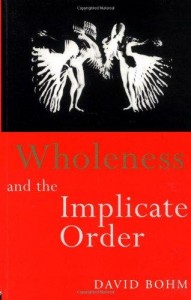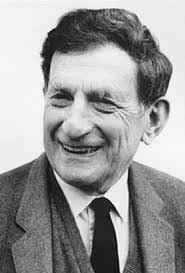一、信堅前言
這篇是繼上面第一集,繼續解說此書的要義,及翻譯此書的 “導論”。為了增強讀者的了解,信堅採取 “中英對照”的格式。



戴維·玻姆 (David Bohm) (1917 – 1992) 跟信堅一樣,是位理論物理學家。他的博士論文指導教授是美國原子能之父, 歐本海默 (J. Robert Oppenheimer, 1904–1967)。另一點須要特別說明的是,玻姆不但是位傑出的理論物理學家,而且對禪修及一乘佛理 (一真法界、諸法實相) 有深入的探討。他曾師從印度見性的東方哲學家Jiddu Krishnamurti (吉杜·克里希那穆)進行了長達十幾年的交往和深層思想對話交流(晚年和達賴喇嘛也有交往),最終提出了整體性/整體運動和隱卷序理論(The wholeness, holomovement and the implicate order) 來解釋世界宇宙的秩序和真實的本質,試圖彌合相對論和量子力學的矛盾,將對宏觀和微觀世界的理解解釋統一起來。此即《華嚴經》所云: “一切皆從法界流,一切還歸於法界。”
[信堅註: 克里希那穆提(1895 – 1986)是二十世紀最卓越的靈性導師,天生具有神通。十四歲時由 “通神學會” 領養。”通神學會” 一直宣揚 “世界導師(World teacher)” 的再臨(東方的”彌勒下生”),並且認為他就是這個再來的 “導師”。他很快就成為堅強無畏、難以歸類的導師。佛學家肯定他是”中觀”的導師,印度教吠檀多學者認為他是徹底的”覺者”,神智學者則認為他是道道地地的”禪師”。]
玻姆提出的隱卷秩序與顯展秩序理論,以“整體性、隱卷秩序 、顯展秩序、捲入與展出、全體運動、 真空能量海”等為基本概念,對宇宙、時空、運動、意識等重大哲學問題,進行了獨特的探討。
玻姆的整體論,就是萬法一體的諸法實相、道通為一,如有機體,不可分割。分裂法有如盲人摸象,井底觀天,管中窺豹,只見一斑。一切萬法,包括所有的科學及人文哲學,都有如在萬法的長流裡的漩渦 (vortices),看似個個獨立,各不相干。但其本質是水的流性。因此研究漩渦,除了研究其結構、性質 (顯展秩序) 外,也必須同時研究整體的水流性質 (隱卷秩序),才能圓滿了解漩渦的特性。
玻姆認為,必須融合唯物論與唯心論,來研究科學,才能達到統一場論 (unified field theory),圓滿解說。宇宙的一切現象,如量子力學、相對論、銀河系、大爆炸論等。不是純數學、唯物的 “超弦理論” 所能達到的。
玻姆的隱卷與顯展秩序理論,有如陰陽,互相消長,互融互攝 (陰中有陽、陽中有陰、陰盛陽衰,陽盛陰衰)。解說易理或物理,孤陰不長,獨陽不生。萬物一太極,由無極中生。
這世界上沒有偶然,只有必然。一切事情的發生,必有其因緣,都是決定性的。我們會感覺偶然,是因為我們智慧不足,資料不夠,無法洞察到所有 “有形、無形” 的時節、因緣。
最後,信堅認為,在這科技時代,闡揚一乘佛道,須要以科技的探討,來引進新的年輕一代。玻姆為此開了先河,與霍金 斯的”能力與強力”等書,也有異曲同功之妙。這也與明朝憨山大師,以一乘佛法來解說儒家、道家言論,引導知識分子進入佛道一樣的用心。
二、Introduction 玻姆序
信堅在此介紹此書的序論。它可作為此書的簡介。
This book is a collection of essays representing the development of my thinking over the past twenty years. A brief introduction will perhaps be useful in order to indicate what are the principal questions that are to be discussed, and how they are connected.
這本書是我過去二十年來對此書義題的思路發展過程的論文集。 在此簡要介紹,可能有助於指出此書所要討論的主要問題以及它們是如何聯繫在一起。
2.1 物不遷論: 萬物一體,海印頓現
I would say that in my scientific and philosophical work, my main concern has been with understanding the nature of reality in general and of consciousness in particular as a coherent whole, which is never static or complete, but which is in an unending process of movement and unfoldment. 在我的科學和哲學著作裡,我最關心的是理解實相的本質以及心意識的作用之間的整體連貫。它是運作,不是靜止或完成的了,而是一個永無止境的過程及展開。永無止息,無始無終。
Thus, when I look back, I see that even as a child I was fascinated by the puzzle, indeed the mystery, of what is the nature of movement. Whenever one thinks of anything, it seems to be apprehended either as static, or as a series of static images. Yet, in the actual experience of movement, one senses an unbroken, undivided process of flow, to which the series of static images in thought is related as a series of ‘still’ photographs might be related to the actuality of a speeding car. 因此,當我回顧過去,發現即使我還在孩童時代時,我就著迷於運動流程的本質這神秘的謎題。每當我思維任何事物,我似乎都以靜態的,或一系列的靜態圖像視之。然而,在運動的實際體驗中,人們感覺到的却是一系列不間斷,不可分割的流動過程。
這是因為人們的視覺暫留所產生的”相續相”,而將思想中的一系列靜態圖像,連接成一個快速行駛的車子 ,有如電影是由一系列的靜態底片,放映在銀幕上,而有生動的影像。這就是如僧肇物不遷論裡所描述的 “旋嵐偃嶽而常靜,江河競注而不流” [參看 “物不遷論解說” ]。
This question was, of course, already raised in essence philosophically more than 2,000 years ago in Zeno’s paradoxes.
這個問題就是在二千多年前,希臘的哲學家芝諾 (西元前490– 前430),所提出的 “芝諾悖論”: 阿喀琉斯與烏龜賽跑(Achilles and the tortoise),善跑的阿喀琉斯永遠追不到烏龜。
芝諾悖論的論點是: 假設阿喀琉斯的跑速是烏龜爬速的十倍。先讓烏龜向前爬行100 公尺,然後阿喀琉斯在後面追。當阿喀琉斯跑了100公尺時,烏龜已經又向前爬行了10公尺,於是,一個新的起點產生了;阿喀琉斯必須繼續追,而當他追到烏龜爬的這10公尺時,烏龜又已經向前爬了1公尺,阿喀琉斯只能再追向那個1公尺。就這樣,烏龜會製造出無窮個起點,它總能在起點與自己之間製造出一個距離,不管這個距離有多小,但只要烏龜不停地奮力向前爬,阿喀琉斯就永遠也追不上烏龜!
芝諾設計了這個悖論,以支持”變化和運動不是真實”的觀點。大小的分別和物體的變動信念是一種錯覺,是心意識的起心動念的假相。這有如數學裡的極限問題: 當n 趨近無限大時,an=1/2n 0. 以此有限觀念,則會陷入牛角尖,無法自拔。這是說,觀念、邏輯如果是有限、不完整的,就會得到錯誤的結論。
如果以不同的觀點來看,不只考慮空間,而再加上時間觀念,則此問題就可輕而易舉的解決: 假設阿喀琉斯每秒跑10公尺,烏龜每秒向前爬行了1公尺。則開始賽跑後,阿喀琉斯在 100/9秒就可追上烏龜,即在11.12秒後,就可超過烏龜。
2.2思維與實相之間的關係
Then there is the further question of what is the relationship of thinking to reality. As careful attention shows, thought itself is in an actual process of movement.
那麼進一步提出的另外一個問題是,思維與實相之間的關係。 如果仔細的分析,思維本身就是一個實際的運動過程。(念念不住,念念成形。相似相續相)
That is to say, one can feel a sense of flow in the ‘stream of consciousness’ not dissimilar to the sense of flow in the movement of matter in general. May not thought itself thus be a part of reality as a whole?
也就是說,人們可以在“意識流”中感受到流動的感覺,與物質的流動感相似。 可能不認為自己是整個實相的一部分? [意識流: 人的心意識像瀑布般流動。強調了思維的不間斷性,即沒有「空白」,始終在「流動」。]
But then, what could it mean for one part of reality to ‘know’ another, and to what extent would this be possible?
那麼實相的一部分“知道”另一部分是什麼意思呢? 在何程程度上,這才是可能的呢?
[信堅補註: 這是一個非常深奧的議題。既然萬物一體,海印頓現,則牽一髮而動全身。那麼實相的一部分是否“知道”另一部分呢? 依照華嚴經、法華經、或僧肇物不遷論,前流後流、前念後念,個個不相知。這就是華嚴經所說: 譬如河中水,湍流競奔逝,各各不相知,諸法亦如是。詳見 一真法界,諸法實相; 華嚴經緣起甚深 解說; 是法住法位 世間相常住 正解; 物不遷論解說 ]。
Does the content of thought merely give us abstract and simplified ‘snapshots’ of reality, or can it go further, somehow to grasp the very essence of the living movement that we sense in actual experience?
思維的內涵只是給我們抽象和簡化實相的“快照( snapshot)”呢,還是能進一步,用來掌握我們在實際經驗中感受到的生活運動的本質?
[信堅補註: 第一個問題的答案是: 一念海印頓現,有如快照,產生一張底片。也有如放映機照在底片,在銀幕上一時頓現全部景象。這就是法華經所說: 是法住法位,世間相常住。肇論偈頌: 旋嵐偃岳而常靜,江河竟注而不流,野馬漂鼓而不動,日月經天而不周。
第二個問題的答案是 “念念成形,而有相似相續動相,才有時空,因果、業報。所謂 “雲馳月運、舟行岸移。境實不遷,唯心妄動、不是風動,不是幡動,仁者心動”。
The notion that the one who thinks (the Ego) is at least in principle completely separate from and independent of the reality that he thinks about is of course firmly embedded in our entire tradition. 認為能思之人(自我),至少在原則上與他所思的實相,完全分離和獨立的觀念,這種觀念,深植在我們的傳統思想之中。[即世俗根深柢固的觀念認為一個思維者(自我),通常聲稱他完全獨立,與現實分離。]
How are we to think coherently of a single, unbroken, flowing actuality of existence as a whole, containing both thought (consciousness) and external reality as we experience it?
我們如何有條理,前後一致地思考,一個單一不間斷的流動,在我們體驗中,如何存在於包含思維(意識)及外在現實的整體中? [這就是問: 既然萬物一體,那我們所覺知的個體運動,到底是何意義? 如何解說呢? ]
[信堅註: 關於這個問題,波姆在 “本體論量子力學(ontological interpretation of quantum mechanics)” 中說: 在新模型裡,電子被理解為一個非區域性的隱卷秩序集合體(nonlocal enfolded ensembles)。在某一特定瞬間,這個集合體可以展開而顯示局部性 (localized),然而在下一瞬間,它又被隱卷,而被其後繼的顯展者所代替。如果這種顯展、卷入的過程,持續而有規則的在相鄰空間快速進行,這就產生一個粒子連續運動的幻象 (相似相續相)。
從更根本上說,粒子只是顯現在我們意識中的抽象、客觀幻象。
譬如水中漩渦(vortex)。真實相是永不停息的流動溪水。可見的事物有如流水上出現的漩渦。這些漩渦相對獨立,保有自己的形態,並持續存在一段時間,同時也可和和其他的漩渦相互作用。然而在本質上,漩渦是由流動的水,因受水下地形的影響,而形成的短暫動態的形態,它只是短暫存在。它的本質是水的,它存在於流水裡,消失在流水裡,也從未與流水分離過。]
2.3 本書七章的內容簡介
It is proposed there that the widespread and pervasive distinctions between people (race, nation, family, profession, etc., etc.), which are now preventing mankind from working together for the common good, and indeed, even for survival, have one of the key factors of their origin in a kind of thought that treats things as inherently divided, disconnected, and ‘broken up’ into yet smaller constituent parts. Each part is considered to be essentially independent and self-existent.
在第一章裡,波姆提出了人類心意識的分裂性思維習性。人類存在著普遍的分別意識(種族,民族,家庭,職業,等等),認為一切事物固有形態是分割,不相連的,及可分解成許多組成的小部分。每個部分被認為是基本上獨立和自我存在。這是目前阻止人類彼此合作而達到共同利益的根本成因。
When man thinks of himself in this way, he will inevitably tend to defend the needs of his own ‘Ego’ against those of the others; or, if he identifies with a group of people of the same kind, he will defend this group in a similar way. He cannot seriously think of mankind as the basic reality, whose claims come first. Even if he does try to consider the needs of mankind he tends to regard humanity as separate from nature, and so on.
當一個人以這種方式想到自己時,他就不可避免地會有強固的我執,捍衛“自我”的需求,或者同類族群的利益。他不能嚴肅地認為人類首要需求,是共同的基本現實。即使他試圖考慮到人類的需要,他也傾向於將人類視為與自然的分離,等等。
What I am proposing here is that man’s general way of thinking of the totality, i.e. his general world view, is crucial for overall order of the human mind itself. If he thinks of the totality as constituted of independent fragments, then that is how his mind will tend to operate, but if he can include everything coherently and harmoniously in an overall whole that is undivided, unbroken, and without a border (for every border is a division or break) then his mind will tend to move in a similar way, and from this will flow an orderly action within the whole.
我在此的建議是,人類的整體思維方式,他的世界觀,是人類思維本身的總體秩序的關鍵。如果把整體看作是獨立的碎片,那麼他的思想就會依此運作。但是如果他能把整個事物,連貫一致、和諧融合在一個不分割的整體上,完整的,沒有邊界,那麼他的思維會傾向於以類似的方式運作,從而將在整個過程中,發揮有秩序的行動。
My suggestion is that a proper world view, appropriate for its time, is generally one of the basic factors that is essential for harmony in the individual and in society as a whole. In chapter 1, it is shown that science itself is demanding a new, non-fragmentary world view, in the sense that the present approach of analysis of the world into independently existent parts does not work very well in modern physics.
我的這個建議是正確的世界觀,是和諧的個體和整個社會。第一章中說明,科學本身正在需求一個新的,非支離破碎的世界觀。在這個意義上,目前的研討方法,將一切事物解析為獨立存在的局部,並不能有效的應用於現代物理。
In chapter 2 we go into the role of language in bringing about fragmentation of thought. It is pointed out that the subject-verb-object structure of modern languages implies that all action arises in a separate subject, and acts either on a separate object, or else reflexively on itself.
在第二章中,我們探討現代語言,為何它是導致一切事物,支離破碎片思維的主角。現代語言的主詞-動詞-受詞結構,意味著所有行為,都有不同的作者與受者。
This pervasive structure leads in the whole of life to a function that divides the totality of existence into separate entities, which are considered to be essentially fixed and static in their nature. We then inquire whether it is possible to experiment with new language forms in which the basic role will be given to the verb rather than to the noun. Such forms will have as their content a series of actions that flow and merge into each other, without sharp separations or breaks. 這種普遍的語言結構,導致將整個生命的作用,分解為單獨固定的,靜態的個體的存在。因此,我們詢問是否有可能嘗試一種新的語言形式,以動詞作為主角。這新語言形式將所有作為視為一系列的流動並且彼此融合,沒有尖銳的分離或破裂的動作。
Thus, both in form and in content, the language will be in harmony with the unbroken flowing movement of existence as a whole. What is proposed here is not a new language as such but, rather, a new mode of using the existing language – the rheomode (flowing mode).
因此,無論在形式上還是在內容,語言上,將與整體存在的不間斷的流動互相和諧。這裡所提出的是一種使用現有的語言的新模式, 叫流動模式 (rheomode)。
In chapter 3 the same questions are considered within a different context. It begins with a discussion of how reality can be considered as in essence a set of forms in an underlying universal movement or process, and then asks how our knowledge can be considered in the same manner. 在第三章裡,我們討論同樣的問題,運用不同語境。(Context: 語境,來龍去脈;在一個整體中,周圍的環境、因果脈絡、環境設定等東西,會根本性的影響 “事件” 本身的意義。而Context就是指這些周圍的環境、因果的來龍去脈。). 它首先討論如何將實相的本質視為一種整體的流動或程序。然後詢問:如何將我們的認知以同樣的方式表達。
Thus, the way could be opened for a world view in which consciousness and reality would not be fragmented from each other. This question is discussed at length and we arrive at the notion that our general world view is itself an overall movement of thought, which has to be viable in the sense that the totality of activities that flow out of it are generally in harmony, both in themselves and with regard to the whole of existence.
因此,可以打開一個新的世界觀,在其中,意識和實相不相互分裂。這個問題將在此章詳細討論。我們得出的看法是,我們的一般世界觀本身,就是思維的整體運動,這個想法必須是可行的,因為它們的活動流程是整體存在和諧一致所流出。此即佛經所謂: 一切法門,莫不從此法界流;一切行門,無不還歸此法界。
Such harmony is seen to be possible only if the world view itself takes part in an unending process of development, evolution, and unfoldment, which fits as part of the universal process that is the ground of all existence.
只有當世界整體觀念本身參與一個無休止的發展、演變和展顯的過程,這種和諧運作是可能達到的。
The next three chapters are rather more technical and mathematical. However, large parts of them should be comprehensible to the non-technical reader, as the technical parts are not entirely necessary for comprehension, although they add significant content for those who can follow them. 接下來的三個章節,則較技術性和數學化。但對於非技術讀者而言,其中大部分內容,應該是可理解的,因為技術部分對於理解並不是完全必要的,儘管它們可以為那些可以了解他們的人,添增重要的內容。
Chapter 4 deals with hidden variables in the quantum theory. The quantum theory is, at present, the most basic way available in physics for understanding the fundamental and universal laws relating to matter and its movement. As such, it must clearly be given serious consideration in any attempt to develop an overall world viewing.
第四章涉及的量子理論的隱變量。量子理論是目前,對於理解有關物質及其運作的基本法則。因此,在任何企圖建立一個整體的世界觀前,必須對它有清楚地認識。
Thus, if we try to use the prevailing world view based on the notion of particles, we discover that the ‘particles’ (such as electrons) can also manifest as waves, that they can move discontinuously, that there are no laws at all that apply in detail to the actual movements of individual particles and that only statistical predictions can be made about large aggregates of such particles.
因此,如果我們嘗試使用基於粒子概念來解說現行的世界觀,我們會發現“粒子”(如電子)也可以表現為波動,它們可以不連續地移動,完全沒有定律 可詳細地應用於解說單顆粒子的實際運動,並且只能對這種顆粒的大聚集體,進行統計學的機遇率預測。
If on the other hand we apply the world view in which the universe is regarded as a continuous field, we find that this field must also be discontinuous, as well as particle-like, and that it is as undermined in its actual behavior as is required in the particle view of relation as a whole.
反之,如果我們採用整體觀,將整個宇宙視為一個連續的能量場,們發現,這個能量場也必須是不連續的,以及持有粒子狀態。
It seems clear, then, that we are faced with deep and radical fragmentation, as well as thoroughgoing confusion, if we try to think of what could be the reality that is treated by our physical laws.
那麼,我們很清楚看出,如果我們試圖通過物理定律來處理實相,則我們面臨著深刻而激進的支離破碎,以及徹底的混亂。
At present physicists tend to avoid this issue by adopting the attitude that our overall views concerning the nature of reality are of little or no importance. All that counts in physical theory is supposed to be the development of mathematical equations that permit us to predict and control the behavior of large statistical aggregates of particles.
目前一般物理學家所採取的態度是避免此問題,認為自然實相的整體觀的並不重要。唯一重要的是研發一個數學公式,用來預測及控制大量粒子的集體統計運作。
Such a goal is not regarded as merely for its pragmatic and technical utility: rather, it has become a presupposition of most work in modern physics that prediction and control of this kind is all that human knowledge is about.
這樣的目標是不被視為僅僅是它的務實和技術用途:更確切地說,它已經成為了大多數現代物理學的大前提。預測和控制大量粒子的集體統計運作是所有人類的知識追求的總目標。
This sort of presupposition is indeed in accord with the general spirit of our age, but it is my main proposal in this book that we cannot thus simply dispense with an overall world view.
這種預設確實符合我們這個時代的一般精神,但這是我在這本書中的主要建議,我們不能就此放棄追求一個量子力學的整體的世界觀。
My suggestion is that at each stage the proper order of operation of the mind requires an overall grasp of what is generally known not only in formal, logical, mathematical terms, but also intuitively, in images, feelings, poetic usage of language, etc.
我的建議是,在每一個階段,心靈的正確運作順序,需要掌握整體,不僅在形式,邏輯,數學術語中,而且在直覺,圖像,感覺,詩意使用語言等方面上。
This kind of overall way of thinking is not only a fertile source of new theoretical ideas: it is needed for the human mind to function in a generally harmonious way, which could in turn help to make possible an orderly and stable society. 這種整體思維方式,不僅是新的理論思想的肥沃源泉,人的心靈以一種和諧的方式發揮作用,從而有助於使產生有秩序而且穩定的社會。
Chapter 4 presents the real and severe problems that confront any attempt to provide a consistent notion of ‘quantum-mechanical reality’, and indicates a certain preliminary approach to a solution of these problems in terms of hidden variables.
第4章介紹了試圖找出和諧一致的“量子力學實相”所面臨的真正和嚴重的問題,並且指出了一些以隱含變數來解決這些問題的的初步方法。
In chapter 5, a different approach to the same problems is explored. This is an inquiry into our basic notions of order. Order in its totality is evidently ultimately undefinable, in the sense that it pervades everything that we are and do (language, thought, feeling, sensation, physical action, the arts, practical activity, etc.).
在第5章中,對相同問題的不同方法,進行了探討。這是對我們對基本秩序概念的查詢。在整體上的秩序顯然是不可逾越的,在某種意義上,它滲透了我們所做的一切(語言,思想,感覺,感情,身體動作,藝術,實踐活動等)。
However, in physics the basic order has for centuries been that of the Cartesian rectilinear grid (extended slightly in the theory of relativity to the curvilinear grid). Physics has had an enormous development during this time, with the appearance of many radically new features, but the basic order has remained essentially unchanged.
然而,在物理學上,幾個世紀以來,基本秩序是笛卡爾直角線性坐標(在相對論中略微延伸至曲線網格)。物理學在這個時期已經有了巨大的發展,出現了許多根本性的新特徵,但其基本秩序基本上沒有變化。
The Cartesian order is suitable for analysis of the world into separately existent parts (e.g. particles or field elements). In this chapter, however, we look into the nature of order with greater generality and depth, and discover that both in relativity and in quantum theory the Cartesian order is leading to serious contradictions and confusion.
笛卡爾秩序適用於將世界分析為單獨存在的局部(例如粒子或場元素)。然而,在本章中,我們以更廣的一般性和深度來研究秩序的本質,並發現在相對論和量子理論中,笛卡爾秩序導致了嚴重的矛盾和混亂。
This is because both theories imply that the actual state of affairs is unbroken wholeness of the universe, rather than analysis into independent parts.
這是因為這兩種理論都意味著,實際狀態是宇宙的完整性,而不是分析為獨立的部分。
Nevertheless, the two theories differ radically in their detailed notions of order . Thus, in relativity, movement is continuous, causally determinate and well defined, while in quantum mechanics it is discontinuous, not causally determinate and not well defined.
然而這兩個理論在其詳細的秩序概念中是根本不同的。在相對論方面,運動是連續的,因果關係是確定性,而且定義明確。而在量子力學中,它是不連續的,不是因果關係的,而且不是很明確定義的。
Each theory is committed to its own notions of essentially static and fragmentary modes of existence (relativity to that of separate events, connectable by signals, and quantum mechanics to a well-defined quantum state).
每個理論都致力於自己的觀念,即基本上是靜態和零碎的存在模式(相對論是與單獨的事件相關,可以通過信號連接的。量子力學是與量子態有明確定義)。
One thus sees that a new kind of theory is needed which drops these basic commitments and at most recovers some essential features of the older theories as abstract forms derived from a deeper reality in which what prevails is unbroken wholeness. 因此,人們認為需要一種新的理論,這種理論基本上落實了這些基本承諾,並且至少恢復了舊理論的一些基本特徵,即從更深層次的現實中得出的抽象形式,其中普遍的是不間斷的整體。
In chapter 6, we go further to begin a more concrete development of a new notion of order, that may be appropriate to a universe of unbroken wholeness. This is the implicate or enfolded order.
在第六章中,我們進一步開始更具體地發展一個新的秩序概念,這可能適合於一個完整的全體。這是隱序或卷序。
In the enfolded order, space and time are no longer the dominant factors determining the relationships of dependence or independence of different elements. Rather, an entirely different sort of basic connection of elements is possible, from which our ordinary notions of space and time, along with those of separately existent material particles, are abstracted as forms derived from the deeper order. These ordinary notions in fact appear in what is called the explicate or unfolded order, which is a special and distinguished form contained within the general totality of all the implicate orders.
在隱序中,空間和時間不再是決定不同成份之相關性或非相關性的主要因素。相反,各成份之間可能存在一個完全不同的、比較基本的關聯,通過這種關聯,我們關於時空以及單獨存在的物質微粒的通常概念,被抽象為源自深層秩序的形式。這些通常概念實際上出現在所謂顯序或展序中,而顯序則是被包含在一切隱序的全面總體中的一種奇特形式。
In chapter 6 the implicate order is introduced in a general way, and discussed mathematically in an appendix. The seventh and last chapter, however, is a more developed (though nontechnical) presentation of the implicate order, along with its relationship to consciousness. This leads to an indication of some lines along which it may be possible to meet the urgent challenge to develop a cosmology and set of general notions concerning the nature of reality that are proper to our time.
在第6章中,以一般方式介紹了隱序,並在附錄中以數學方式進行了討論。然而,第七章和最後一章是一個比較發達的(雖然非技術性的)隱序的呈現,以及它與意識的關係。這表明了一些可能會遇到緊急挑戰的一些線索,以發展關於我們時代適當的現實性質的宇宙學和一般概念。
Finally, it is hoped that the presentation of the material in these essays may help to convey to the reader how the subject itself has actually unfolded, so that the form of the book is, as it were, an example of what may be meant by the content.
最後,作者希望在這些論文中所介紹的材料,可有助於向讀者傳達主題本身是如何實際展現出來的,因此本書的形式就是一個例子,內容。

信堅 先生您好:
首先感謝 先生 貼第二集, 您用心良苦,提攜後進。
後學,目前閱讀進度至第四章 (133 / 306) ,無力感猶然而生。
先生於前文所說:此書是論文。果然無誤。
後學「再」不敢言「翻譯」,我已擬定「學習進程」,此書先閱畢,重習(Quantum theory)。
以下是後學,閱覽 先生譯作之後的個人體會,有誤之處還請 先生指教。
2.1 物不遷論: 萬物一體,海印頓現
I would say that in my scientific and philosophical work, my main concern has been with understanding the nature of reality in general and of consciousness in particular as a coherent[united as or forming a whole.] whole, which is never static or complete, but which is in an unending process of movement and unfoldment.
在我的科學和哲學著作裡,我最關心的是理解實相的本質以及心意識的作用之間的整體連貫。它是運作,不是靜止或完成的了,而是一個永無止境的過程及展開。永無止息,無始無終。
[我最關注兩件事,其一是:什麼是真理?其二是:當人的心意識功能真正達到統合的境界時,應是一無止境的開展。] 百魔
2.2思維與實相之間的關係
That is to say, one can feel a sense of flow in the ‘stream of consciousness’ not dissimilar to the sense of flow in the movement of matter in general. May not thought itself thus be a part of reality as a whole?
Then there is the further question of what is the relationship of thinking to reality. As careful attention shows, thought itself is in an actual process of movement.
那麼進一步提出的另外一個問題是,思維與實相之間的關係。
[我們是如何透過,想(思維)而見「真」呢?] 百魔
如果仔細的分析,思維本身就是一個實際的運動過程。(念念不住,念念成形。相似相續相)
That is to say, one can feel a sense of flow in the ‘stream of consciousness’ not dissimilar[not alike; different.] to the sense of flow in the movement of matter in general. May not thought itself thus be a part of reality as a whole?
That is to say, one can feel a sense of flow in the ‘stream of consciousness’ not dissimilar to the sense of flow in the movement of matter in general. May not thought itself thus be a part of reality as a whole?
也就是說,人們可以在“意識流”中感受到流動的感覺,與物質的流動感相似。 可能不認為自己是整個實相的一部分? [意識流: 人的心意識像瀑布般流動。強調了思維的不間斷性,即沒有「空白」,始終在「流動」。]
[大家應該都有同樣的體會,我們的思緒如滔滔江水從未止歇。唯反觀自照「浮水之木,焉知全般?」] 百魔
But then, what could it mean for one part of reality to ‘know’ another, and to what extent would this be possible?
那麼實相的一部分“知道”另一部分是什麼意思呢? 在何程程度上,這才是可能的呢?
[後學以為此段論述與「測不準原理(Heisenberg’s indeterminacy principle)」的論述內容有關,前輩在描述「現象」常以「類人稱」的方式形容,誤解之處,煩 先生指正。] 百魔
[信堅補註: 這是一個非常深奧的議題。既然萬物一體,海印頓現,則牽一髮而動全身。那麼實相的一部分是否“知道”另一部分呢? 依照華嚴經、法華經、或僧肇物不遷論,前流後流、前念後念,個個不相知。這就是華嚴經所說: 譬如河中水,湍流競奔逝,各各不相知,諸法亦如是。詳見 一真法界,諸法實相; 華嚴經緣起甚深 解說; 是法住法位 世間相常住 正解; 物不遷論解說 ]。
The notion that the one who thinks (the Ego) is at least in principle completely separate from and independent of the reality that he thinks about is of course firmly embedded in our entire tradition.
認為能思之人(自我),至少在原則上與他所思的實相,完全分離和獨立的觀念,這種觀念,深植在我們的傳統思想之中。
[即世俗根深柢固的觀念認為一個思維者(自我),通常聲稱他完全獨立,與現實分離。]
[「自以為是」 這種心態長期以來讓「實相,真理」無法張顯] 百魔
百魔 叩學
百魔師兄:
多謝師兄詳細閱讀此文及回應。玻姆此書,對研究科學理論的人來說,簡直是提醐灌頂,注入嶄新的觀念及思維方式。師兄了解了之後,能有無量法喜,表示師兄覺知已開,能信解一真法界,諸法實相。
師兄的體會,相當正確。其中的幾個重要論點,在信堅剛張貼的第三集,有更詳細的解說。
此書不但哲理、物理難懂,他的英文也相當難懂。此書的重要觀念都包含在此園地的三集文章裡。其他章節,都是應用。因此信堅對此書的翻譯及解說,可能到此為止。有興趣者,可以此為基礎,翻譯其他章節。
對實相與心意識方面的更深理解,則須要研讀一乘佛經,如華嚴經、楞嚴經、維摩詰經,等等。
信堅
感謝信堅師兄極力宏揚佛法
Ray
Ray 師兄:
真高興師兄仍然繼續參觀信堅園地,也感謝留言鼓勵。歡迎來函,批評指教。
信堅